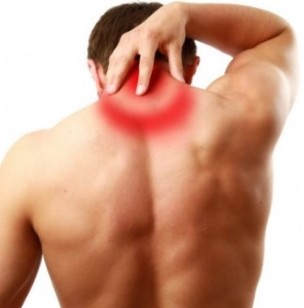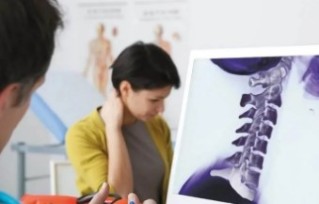Osteochondrosis is a disease of the spine, which is characterized by the development of changes in cartilage intervertebral disc and reactive processes in the surrounding tissues.
Cervical osteochondrosis spine is different in its manifestations from the thoracic and lumbar osteochondrosis. Symptoms of cervical degenerative disc disease associated with the anatomical features of the cervical spine. Dimensions of the cervical vertebrae are smaller than other departments. Cervical is constantly under load, holding the head, and it also has great mobility.

The causes of osteochondrosis
The reasons for the development of the disease, primarily caused by age-related aging of the body and develops the destruction of bone and cartilage. You can also call the following causes of osteochondrosis:
- violations of posture,
- decrease in motor activity in a result of sedentary lifestyle,
- weight, which is the result of metabolic disorders, exerts load on the intervertebral discs,
- hereditary factor
- prolonged physical load,
- anomalies of the spine.
Uniform exercise, proper nutrition and a healthy lifestyle significantly reduces the chances of developing the disease, but also reduce the impact on overall health.
The symptoms of cervical osteochondrosis
Manifestations of cervical degenerative disc disease differ from symptoms in other parts of the spine. This is due to the fact that the cervical vertebrae have a different structure and are very close. Therefore, any misalignment manifested by severe pain. In addition, in the cervical spine are often trapped nerve bundle and artery.
Cervical osteochondrosis manifested by the following symptoms:
- The sensation of pain – the pain can be felt in different parts of the body. This is due to the fact that there is a pinched nerve endings and muscles of the corresponding part of the body.
- Weakness in upper limbs manifests itself due to entrapment of the nerve endings that are responsible for motor activity.
- Difficulty when turning the head, the crunch of vertebrae in the cervical spine occur due to changes in the structure of the intervertebral disc, the emergence of bone formation.
- The low sensitivity of the hands.
- Weakness and dizziness occur due to pinching of the artery that provides blood flow and nutrition to the brain.
- Hearing loss and vision – appears in the last stage of the disease when blood circulation in the cerebellum.
Signs of osteochondrosis of the cervical
- Radicular syndrome is characterized by a pinched nerve bundle in the neck. Manifested by severe pain which may be felt in the shoulders, shoulder blade.
- Vertebral syndrome – manifested severe headaches, pain in the temples and the nape.
- Reflex syndrome is characterized by severe pain in the cervical spine, which may be aggravated by any head movement. Pain may move to the shoulder and chest.
- A cardinal syndrome is reminiscent of angina, to determine which is extremely difficult.
The degree of development of osteochondrosis of the spine
As its development, the disease goes through several stages. Each stage has its own characteristics and is characterized by certain features.
- Stage 1. Bone and cartilage tissue of the vertebrae gradually begins to break down. Symptoms are hardly noticeable. And very often patients simply do not notice, and associated fatigue and pain with fatigue and stress.
- Stage 2. The height of the disc begins to decrease, it cracks. The patient feels constant pain, weakness, numbness of the face.
- Stage 3. Begin to form of herniated discs, damaged cervical vessels and muscles. There are complaints of dizziness, pain in the neck.
- Stage 4. Bone tissue that protects the vertebrae from excess load begins to grow, causing zaselyalsya nerve endings. There is a stiffness in the movements, damaged the neighboring joints.
The danger of cervical degenerative disc disease
In the cervical spine is a large number of nerves and arteries that provide the brain power. In case of violation of their work, the brain will not receive adequate nutrition for normal functioning. This situation may disrupt the motor activity of man, to cause pain in the limbs and loss of coordination.
In advanced stages of osteoarthritis may develop ischemia, stroke and other diseases dangerous to human life.
Therefore, when any of the symptoms associated with this disease, it is recommended to seek medical help.
Diagnosis of the cervical spine
For examination of diseases of the spine the following types of diagnostics:
- x-ray is an ineffective way to diagnose this disease
- MRI (magnetic resonance imaging)shows the bone structure, resulting to a herniated disc and their sizes,
- CT (computed tomography) is ineffective in comparison with MRI, as with this method the diagnosis is difficult to determine the size of the hernia,
- Ultrasonic duplex scanning is used in the case when the violation of the General circulation. The survey shows the existing flow velocity, and the presence of barriers in his way.
Treatment of cervical osteochondrosis

Treatment of cervical degenerative disc disease of the spine should be complex, depending on the situation. A positive effect can be achieved through an integrated and individual approach, which involves drug therapy, physio treatments, physiotherapy, massage, are also used by traditional medicine.
In the period of acute treatment of cervical osteochondrosis is aimed at improving blood circulation, getting rid of muscle spasms. In this case, the cosmetics, which improves blood flow, anti-inflammatory and pain medication, vitamin complex.
Physical therapy for degenerative disc disease of the cervical
Therapeutic gymnastics gives visible results and is less dangerous at the stage of recovery. The principle of physiotherapy is to restore blood flow to damaged parts of the body. Exercises physical therapy the patient should not feel pain and discomfort.
A set of exercises for the cervical spine is designed to strengthen neck muscles, and also acts as a prevent the development of cervical degenerative disc disease.
Massage in osteochondrosis of the cervical spine
The massage is to strengthen muscle tone and relieve pain. Depending on the stage of the disease, are different massage techniques. Classical massage techniques include:
- stroking – this technique is the impact on the superficial layers of the skin. Massage begins with the neck area and continues to the clavicula and underarms.
- squeezing – in this case, the impact in the course of the massage is on the deeper layers of the skin. Across the neck with thumb and forefinger to perform motion capture of skin that resemble squeezing.
- rubbing is performed with the purpose of warming up and relaxation of the skin to improve blood circulation in the neck area of the cervical spine.
- kneading – has special restrictions, so the effect on the underlying tissue. If improperly performed, this technique can harm the patient.
In cases where the patient's sensation of pain occurs on only one side, massage should be started to comply with the healthy part of the neck, gradually moving to the part of the spine, where pain appears.
Massage can be performed at home and in a medical facility. However, in the course of its execution should be very careful not to provoke the exacerbation of the disease or make it worse.
Prevention of cervical degenerative disc disease
To prevent the occurrence and development of disease, it is recommended to follow the simple rules:
- to lead a healthy lifestyle, exercise, regular visits to the pool;
- to diversify the diet of foods rich in magnesium and calcium;
- in the case of sedentary work a few times a day to limber up;
- for sleep, you should choose an orthopedic mattress and a comfortable pillow.
















